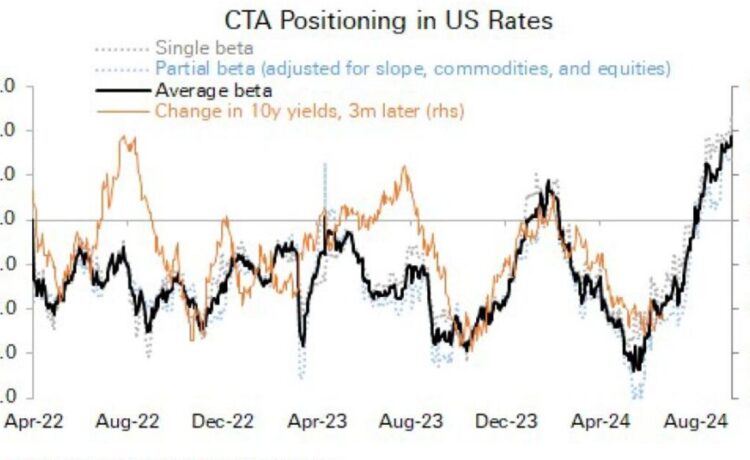(Bloomberg) — This month’s rout in Treasuries is hammering trend-chasing quant investors who had built up bullish positions in bonds, the latest setback for a strategy that has misfired badly at times this year amid market convulsions.
The quants, known as commodity trading advisers, seek to profit from momentum in assets such as bonds, stocks and currencies. Most recently, they piled into wagers that US government debt would keep rallying as the Federal Reserve launched interest-rate cuts, amassing the largest long positions in three years as of late September, according to data compiled by Deutsche Bank AG.
The positioning backfired instead as 10-year Treasury yields surged by more than 60 basis points, defying expectations that the start of the first easing cycle in four years would provide a tailwind to bonds. And it happened just as the $358 billion CTA cohort was struggling to recover from steep losses in early August, when the unwinding of trades made with borrowed yen triggered a reversal of a number of winning wagers earlier in the year.
“The year of the whipsaw continues,” said Andrew Beer, founder of Dynamic Beta Investments, a firm that runs funds that replicate strategies made by CTAs and hedge funds. “Just as CTAs load up on a trend, it reverses.”
The ill-timed bond positions, combined with bets against the dollar, left CTAs with losses of 1.8% this month through Oct. 28, all but wiping out all of this year’s gains, according to data compiled by Societe Generale SA. And it may be just the start. Should the bond rout deepen, Nomura Holdings Inc. estimates that CTAs and other trend followers may have to dump another $240 billion in bonds, more than twice what it reckons they have already liquidated.
Prior to October, Treasuries had been rallying for five months, marking the best run in 14 years. Those steady gains emboldened those who follow momentum to load up and magnify the trade.
By late September, Deutsche Bank’s strategists noted an unusually high correlation between returns of CTAs and bond moves — to the tune of two-standard deviations from the norm, in Wall Street parlance. That suggested these funds had built “extreme” long fixed-income positions, leaving the market vulnerable in the event of a reversal, strategists including Steven Zeng warned.
The warning soon became a reality. Better-than-expected economic data quickly prompted traders to pare back the expectations of aggressive Fed easing. Rising speculation that Republicans may control both the White House and Congress has also hit appetite for longer-term bonds, on concern the outlook for fiscal discipline and inflation will worsen under former President Donald Trump’s tax-cut and tariff plans. Treasury investors have lost 2.4% so far this month, trimming this year’s gain to just 1.3%.
It’s the latest sign that smart-money traders are getting outwitted by the relentless US economic expansion that’s stoking fresh volatility in the world’s biggest debt market.
CTAs have been thrown off by quick reversals in the bonds throughout the year. They were consistently short bonds early this year until April, when the market troughed. The rally then reignited in July amid a surge in the Japanese yen, a short-lived decline in stocks and some evidence of cooling US growth and inflation. CTAs flipped to net longs soon after and kept building up the positions, according to Deutsche Bank’s data.
“The yield environment has been very tricky,” said Kathryn Kaminski, chief research strategist and portfolio manager at AlphaSimplex Group, which manages quant funds, including CTAs. “For us it’s been very, very back-and-forth.”
The $2 billion Virtus AlphaSimplex Managed Futures Strategy Fund declined 2.5% this month, extending this year’s fall to 3.4%. Kaminski said their systematic models still favor long Treasuries on a net basis, but the trading signals have weakened over recent weeks, so they have trimmed exposures.
All told, it’s hard to know precisely how much of CTA’s long-bond trades remains in place, because different funds use different technical signals and time frames to generate buy or sell signals.
While Nomura’s derivative guru Charlie McElligott estimates that positioning in bonds and short-term rate instruments may still be quite high, exceeding $200 billion, Suhail Shaikh, chief investment officer at London-based Fulcrum Asset Management LLP, said his firm’s model showed CTAs liquidated about 80% of its long-bond exposures in three weeks.
‘Lot of Liquidation’
What these investors and strategists can agree on is that the liquidation by these players exacerbated the bond selloff.
The rout “came off the back of significant longs having been put on by the quant community, by the macro community, by the CTAs,” said Shaikh. “So there’s been a lot of liquidation of exposures.”
Among funds that exited their bullish bond positions is the $98 million Return Stacked Bonds & Managed Futures ETF (ticker RSBT), which aims to mimic CTA exposures as part of its strategy. In early October, the fund had the largest interest-rate exposure, or duration risks, since its inception in February 2023, according to Corey Hoffstein, chief investment officer of Newfound Research LLC, which manages the ETF. By late last week, the exposure had cut to almost zero. The fund lost 5.9% so far in October.
The iMGP DBi Managed Futures Strategy ETF (DBMF), which touts an easy-access version of a CTA strategy and is a proxy of the industry’s exposure, had a similar tough October. The fund tumbled 2.9% this month, cutting this year’s gain to about 8.8%.
“No one is probably making a killing from bonds right now,” Hoffstein said.
©2024 Bloomberg L.P.

















